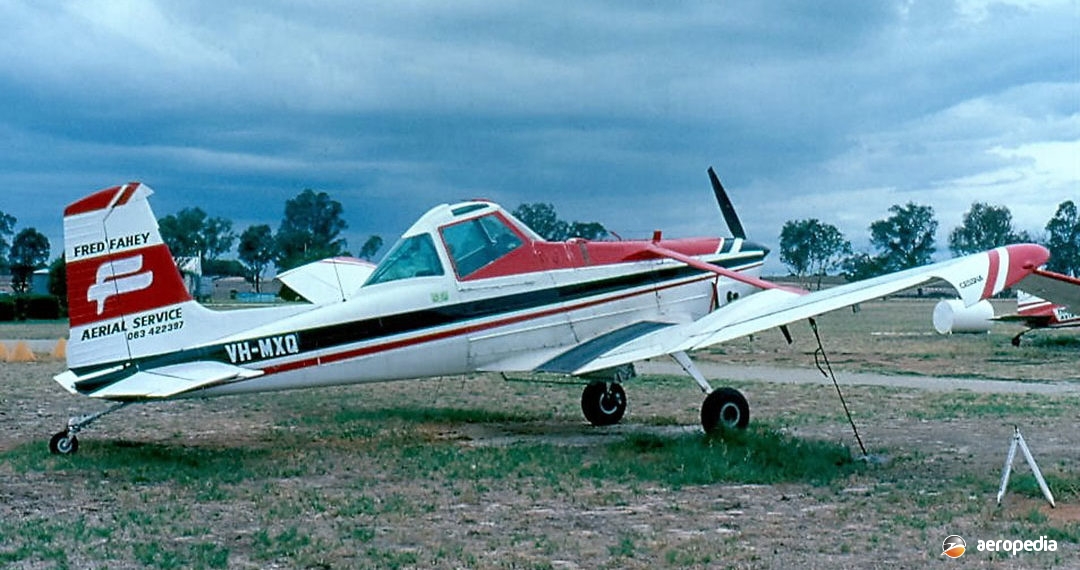Photograph:
Cessna A188B Ag Truck A2 VH-MXQ (c/n 18803470T) at Cowra, NSW (David C Eyre)
Country of origin:
United States of America
Description:
Single-seat agricultural monoplane
Power Plant:
(Model 188 Ag Husky)
One 231 kw (310 hp) Teledyne Continental TIO-520-T six-cylinder horizontally-opposed fuel injected and turbo-supercharged air-cooled engine
Specifications:
- Wingspan: 12.7 m (41 ft 8 in)
- Length: 8.08 m (26 ft 6 in)
- Height: 2.49 m (8 ft 2 in)
- Wing area: 19 m² (205 sq ft)
- Max speed at sea level: 203 km/h (126 mph)
- Cruising speed at 75 % power at 1,980 m (6,500 ft): 190 km/h (118 mph)
- Initial rate of climb: 155 m/min (510 ft/min)
- Max certificated altitude: 4,267 m (14,000 ft)
- Range with 45 mins reserve at 75% power: 394 km (245 miles)
- Empty weight: 1,040 kg (2,293 lb)
- Loaded weight: 1,996 kg (4,400 lb)
History:
Design of the Cessna 188 series of agricultural aircraft began following a market research and engineering survey of agricultural operators around the world by Cessna. The Model 188 was placed in production originally in two basic variants, a 172 kw (230 hp) variant with a standard fixed-pitch propeller, and a second with a 224 kw (300 hp) engine with a constant-speed propeller. The prototype flew for the first time on 19 February 1965, and production deliveries commenced during the following year.
The fuselage was built in two sections. The front section was built around a tubular steel frame, which incorporated the turnover structure, and the tail section immediately behind the cockpit was of semi-monocoque construction sealed to protect the rear fuselage from corrosive chemicals. The fibreglass hopper, with a capacity for 757 litres (166 Imp gals) of liquid chemical or 817 kg (1,800 lb) of dry material, was equipped with a stainless steel baffle and was designed so that it could be changed over from liquid to dry materials in a minimum of time and without special tools. Typical of Cessna designs, the wing flaps were located outboard of the undercarriage to reduce stone damage when taxiing on rough ground, and were manually operated. All versions of the Ag Wagon had operating speeds around 137 km/h to 162 km/h (85 mph to 110 mph) at restricted category weight. Effective dispersal swarth was about 21.234 m (70 ft).
In 1971 the basic Model 230 was re-named the Ag Pickup, and a version with a larger hopper became known as the Ag Truck. Production of the Ag Pickup ceased in 1982 after 53 were built, but the Ag Truck continued and, in mid 1985 when production was suspended, 1,949 examples had been completed, the last model having the 224 kw (300 hp) Continental IO-520-D engine. Another model known as the Ag Husky, was also introduced to the range in 1983, this being powered by the 231 kw (310 hp) Continental TSIO-520-T turbocharged engine, and 385 examples of this variant had been completed when production was suspended in 1985.
A number of examples have operated in Australasia over the years. Three examples operated by Pays Air Services at Scone, NSW were rebuilt and fitted with 300 kw (400 hp) Lycoming IO-720 engines, these becoming known as the Cessna A188B-A2, being VH-UJQ (c/n 18803423TA -ex N2186J) registered on 1 June 1979; a T188C Ag Husky VH-PAU (c/n T18803891T -ex N9962J) registered on 18 January 1984; and a T188C Ag Husky A2 VH-NAB (c/n T18803732T -ex N4341J) registered on 28 March 1985.
Some 14 examples of the series are known to have been converted to the IO-720 engine, mostly T188Cs, between 1989 and 1992.

